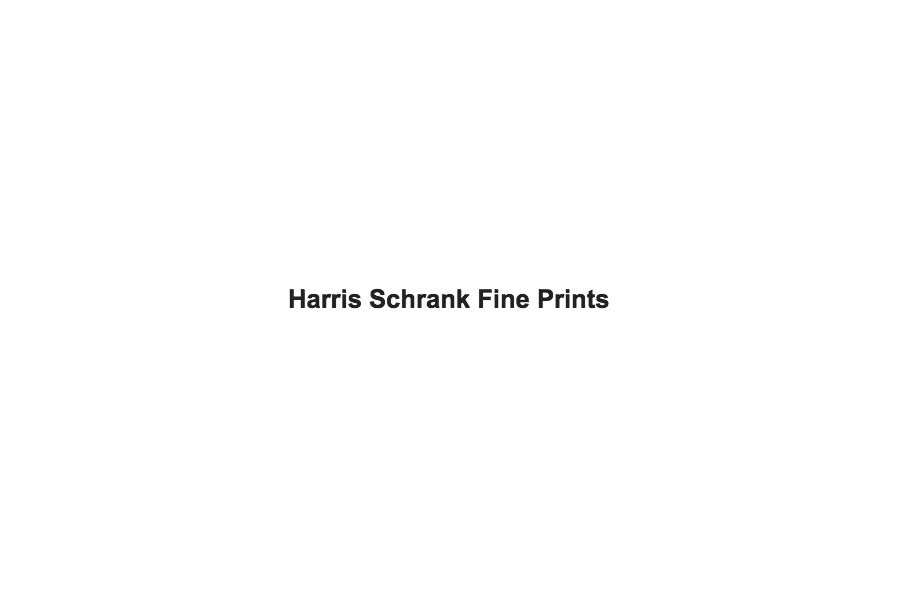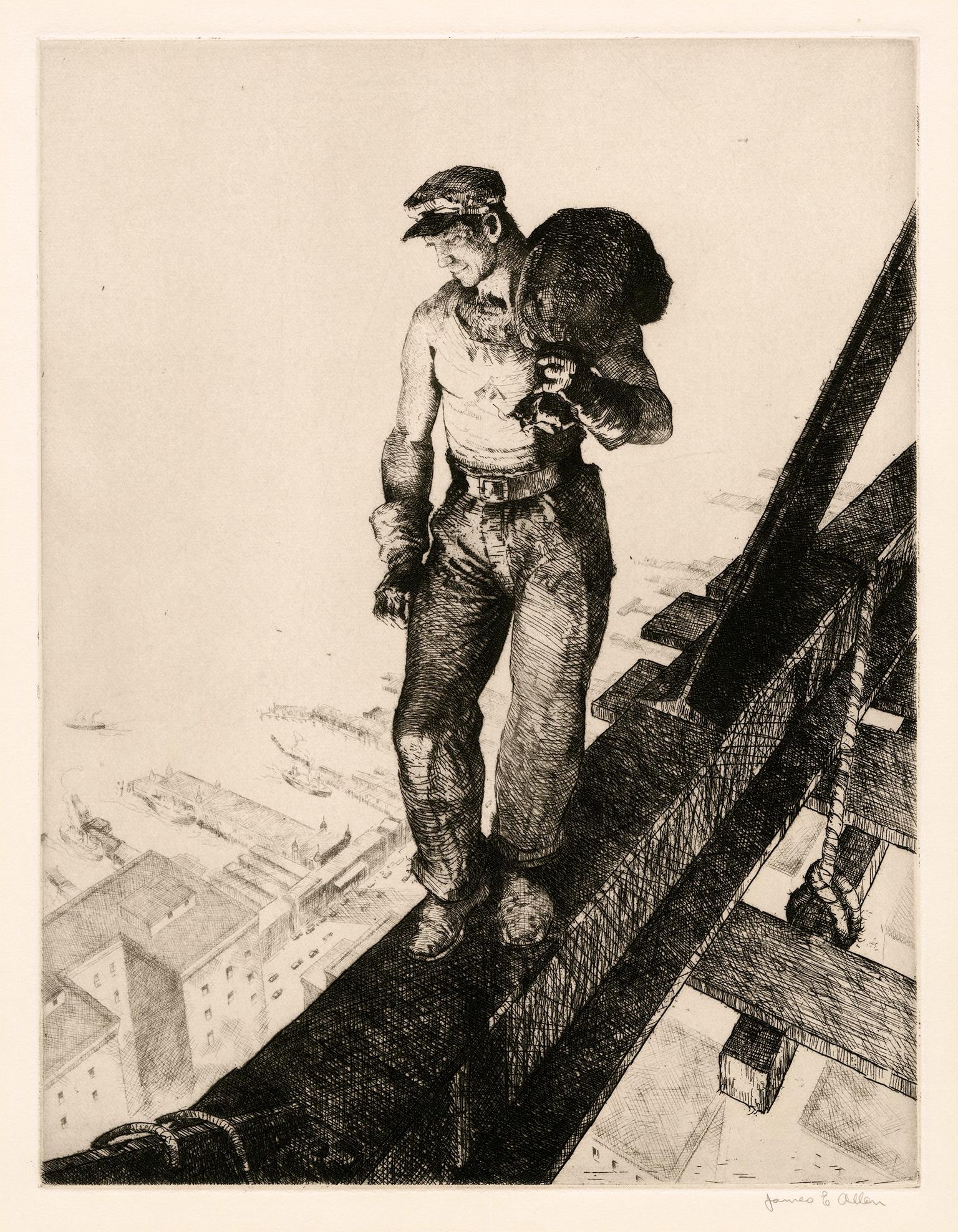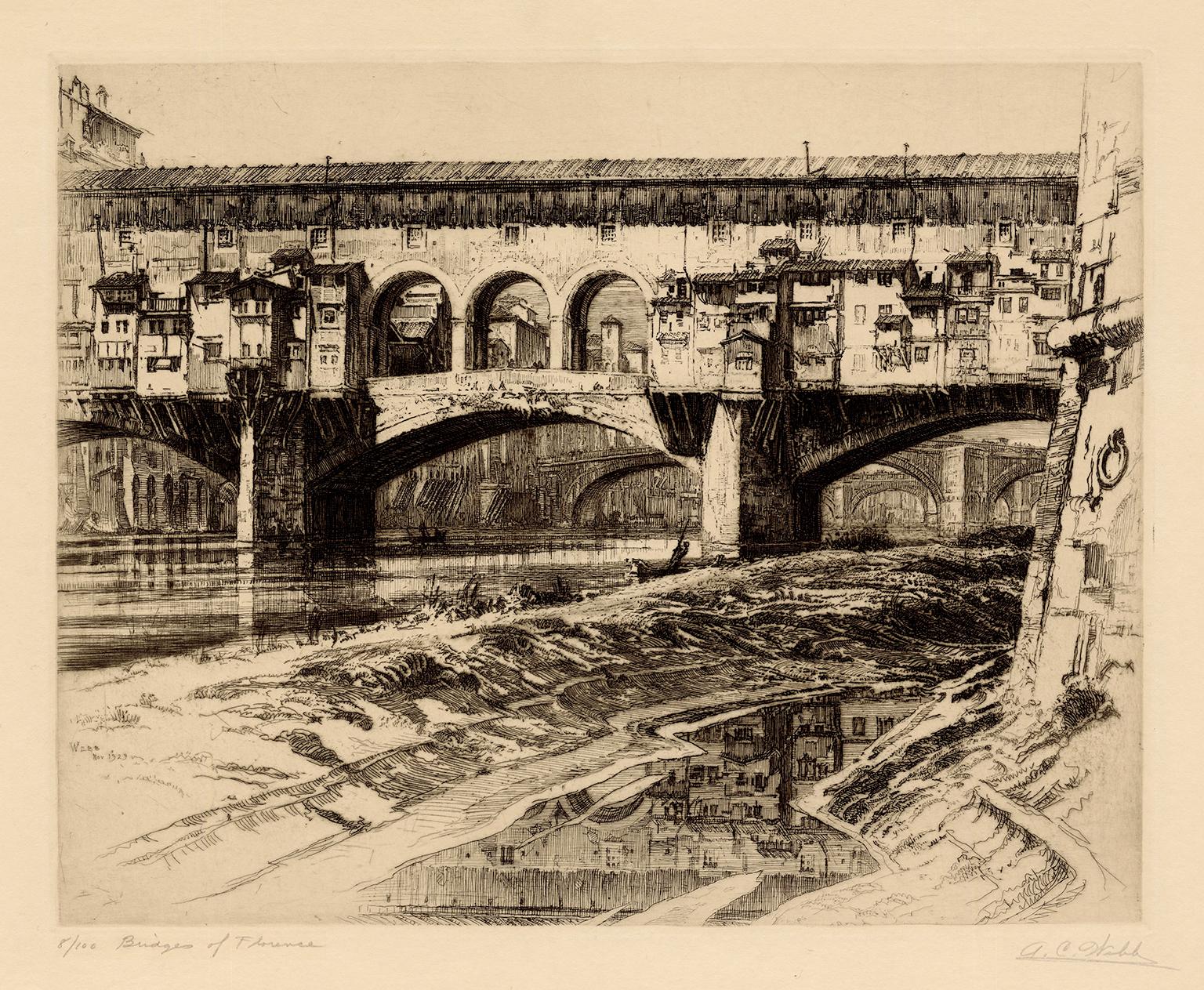Items Similar to Flying Concellos
Want more images or videos?
Request additional images or videos from the seller
1 of 10
Reginald MarshFlying Concellos1936
1936
About the Item
Reginald Marsh (1898-1954), Flying Concellos, etching, 1936, signed in pencil lower right and annotated “40 Proofs” lower left. Reference: Sasowsky 163, fourth state (of 4). In excellent condition, on a RIVES wove paper, the full sheet with deckle edges, with full margins (tiny hinges upper corners from prior hinging), 8 x 10, the sheet 11 3/8 x 15 3/4 inches, archival matting.
A fine impression.
Flying Concellos was printed in a 11 or so proofs, then 15 impressions by Marsh in July of 1936 and another 10 in October ’36 by Charles White. Since this impression is in such fine condition we surmise that this is one of the White impressions. The annotation “40 proofs” by Marsh is typical for him, suggesting his hope rather than the reality – Sasowsky indicates that only 25 impressions were printed of the final state.
Arthur Concello’s act made circus history when his wife Antoinette joined him in performing the triple somersault in the late ’30’s at Madison Square Garden, New York, the two performers both attaining the triple to display the highest peak of team flying ever witnessed at that time.
Marsh brings us up to eye level with the other performers in this daring composition.
- Creator:Reginald Marsh (1898-1954, American)
- Creation Year:1936
- Dimensions:Height: 11.38 in (28.91 cm)Width: 15.75 in (40.01 cm)
- Medium:
- Movement & Style:
- Period:
- Condition:
- Gallery Location:New York, NY
- Reference Number:1stDibs: LU51531454113

About the Seller
4.9
Recognized Seller
These prestigious sellers are industry leaders and represent the highest echelon for item quality and design.
Established in 2000
1stDibs seller since 2016
99 sales on 1stDibs
Typical response time: 3 hours
Associations
International Fine Print Dealers Association
- ShippingRetrieving quote...Ships From: New York, NY
- Return PolicyA return for this item may be initiated within 7 days of delivery.
More From This SellerView All
- Subway StairsBy John SloanLocated in New York, NYJohn Sloan (1871-1951), Subway Stairs, etching, 1926, signed, titled and inscribed “working proof 1;” also with the notation “JS imp” in pencil bottom margin [with the name and date ...Category
1920s American Realist Figurative Prints
MaterialsEtching
- Merry-Go-RoundBy Reginald MarshLocated in New York, NYReginald Marsh (1898-1954), Merry-Go-Round, etching and engraving, 1938, signed in pencil lower right and inscribed Forty Proofs lower left, [also signed in the plate lower left and inscribed SC]. Reference: Sasowsky 179, fourth state (of 4). In good condition, with margins (a paper loss upper right corner well outside of the platemark, stains from prior hinging, notations in pencil lower margin edge). 10 x 8, the sheet 11 1/2 x 9 1/8 inches. A very good impression, printed in black on a wove paper with a partial FRANCE watermark. Sasowsky notes that Marsh printed 15 impressions of this state (and only one or two of the prior states), and considered only 10 of the 15 valuable. His notation “Forty Proofs” is therefore surely an expression of a hoped-for edition size, as opposed to an actual edition size. We have found this quite often the case with Marsh prints – he indicates an edition size but the actual number of impressions printed is considerably smaller. There is an eerie, almost ominous note in this, as in several of Marsh’s merry-go-round prints...Category
1930s American Realist Figurative Prints
MaterialsEngraving, Etching
- East Tenth Street JungleBy Reginald MarshLocated in New York, NYReginald Marsh (1898-1954), East Tenth Street Jungle, 1934, etching, signed and annotated “Second Proof, First State”, in pencil [also initialed and dated in the plate]. Reference: S...Category
1930s American Realist Figurative Prints
MaterialsEtching
- Fashions of the PastBy John SloanLocated in New York, NYJohn Sloan (American 1871 – 1954), Fashions of the Past, etching and aquatint, 1926, signed and titled by the artist in pencil (Morse 224 IV/IV), also signed by the printer. From the...Category
1920s American Realist Figurative Prints
MaterialsEtching, Aquatint
- Tatoo-Shave-HaircutBy Reginald MarshLocated in New York, NYReginald Marsh (1898-1934), Tattoo-Shave-Haircut, etching, 1932. Signed, titled (“Tattoo-Haircut-Shave”), dedicated (“for Arnold Newman”), and annotated (“Fourth State. First of Two Prints”). Reference: Sasowsky 140. On cream wove paper. In very good condition, with small margins (as trimmed, slightly irregularly, by the artist) (slight foxing in margins), remains of prior hinging verso; 9 7/8 x 9 3/4, the sheet 10 15/16 x 10 5/8 inches; archival matting. A very fine rich black impression; we have not seen impressions of comparable quality on the market. Provenance: Estate of Arnold Newman. Arnold Newman (1918-2006) was one of the great 20th Century masters of photography, and a friend of many leading artists; it is appears that Marsh took special care in printing this impression for Newman. Sasowsky calls for 10 states of Tattoo-Shave, based largely on Marsh’s notes. But the states are not clearly delineated (e.g., his States 3 and 4, one proof each, are characterized by Marsh as “Engraving added”; no information is given for State 5). The design for the print was complete in the first state, and subsequent state changes were not, apparently, major. This impression does not appear to differ in etching lines from the final state impression shown in Sasowsky. Its inscription (as a Fourth State, by Marsh), as well as its rich inking and quality, attest to its being a proof before the edition (of about 34 impressions), but the state of this print (and, presumably of many of the other several proof impressions) cannot at this time be stated with confidence. Marsh printed this impression personally (we recall his famous answer to a question about the size of his editions: “Since I do practically all my own printing, I do not limit the edition. The buyer limits the edition – he rarely buys, I rarely print”). Tattoo-Shave-Haircut depicts a scene in the Bowery, a section of New York’s Lower East Side, during the Great Depression. The building and train structures in the top half of the print recall Piranesi’s Carceri...Category
1930s American Realist Figurative Prints
MaterialsEtching
- Merry-Go-Round, 1930By Reginald MarshLocated in New York, NYReginald Marsh (1898-1954), Merry-Go-Round, etching, 1930, signed in pencil lower right and numbered "24" lower left. In very good condition, with margins (cut irregularly,...Category
1930s American Realist Figurative Prints
MaterialsEtching
You May Also Like
- 'Spiderboy' — 1930s American Realism, New York CityBy James AllenLocated in Myrtle Beach, SCJames Allen, 'Spiderboy', 1937, etching, edition 40, Ryan 86. Signed in pencil. A superb, richly-inked impression, on cream laid paper, with full margins (1 1/4 to 2 7/8 inches). A s...Category
1930s American Realist Figurative Prints
MaterialsEtching
- 'The Connectors' — 1930s American Realism, New York CityBy James AllenLocated in Myrtle Beach, SCJames Allen, 'The Connectors', 1934, etching, edition not stated, Ryan 66. Signed in pencil. A superb, richly-inked impression, on handmade, cream laid paper, with margins (1/2 to 1...Category
1930s American Realist Figurative Prints
MaterialsEtching
- 'Scratchin' High' — early American rodeoBy Edward BoreinLocated in Myrtle Beach, SC'Scratchin' High', etching, edition not stated, c. 1919. Signed in pencil. A fine, rich impression, in warm black ink, on cream wove paper, with margins (11/16 to 2 1/8 inches). Two small spots of toning in the bottom right margin, away from the image; barely visible printing creases in the top left margin and the middle right background, otherwise in very good condition. Matted to museum standards, unframed. ABOUT THIS WORK The cowboy's work of breaking wild horses into riding horses evolved into the competitive sport of professional rodeo in the 1880s. In 1919 at the Calgary Stampede in Alberta, Canada, Borein sketched a rider on the famous bucking horse named 'I-See-U'. He later made this etching of the dramatic scene, entitling it 'Scratchin' High'. ''Scratching'' refers to the rider's technique of maintaining balance on a bucking horse by a continuous movement of the feet in a kicking motion. Impressions of this work are in the permanent collections of the Buffalo Bill Center of the West (online), and the Whitney Western Art Museum. ABOUT THE ARTIST No other artist captured the "disappearing West" with the authenticity and spirit of John Edward Borein (1872-1945). A native of the San Francisco Bay Area, Borein rode south in 1893 at the age of twenty-one, and over the next few years, worked his way through California and the vast stretch of Mexico. While on the range, the young cowboy sketched...Category
1910s American Realist Figurative Prints
MaterialsEtching
- The Elevated, East 42nd Street, New YorkBy William MonkLocated in Myrtle Beach, SCWilliam Monk, 'The Elevated, East 42nd Street, New York', etching, 1910. Signed in pencil and titled in the bottom right sheet corner. Signed in the plate, lower right. A superb, ric...Category
1910s American Realist Figurative Prints
MaterialsEtching
- Bridges of FlorenceLocated in Myrtle Beach, SCAlonzo C. Webb, 'Bridges of Florence', etching, 1929, edition 100. Signed and titled in pencil. Signed and dated in the plate, lower left. A superb, richly-inked impression, in warm ...Category
1920s American Realist Figurative Prints
MaterialsEtching
- Racamadour (French Church Series #10)By John Taylor ArmsLocated in Myrtle Beach, SC'Rocamadour' (French Church Series # 10), etching, 1927, edition 50, Fletcher 186. Signed, dated, and annotated 'First State' in pencil. Titled and dated 'Rocamadour 1926' in the plate, bottom right. A superb, finely detailed impression, in dark brown ink, on buff laid Japan paper, with full margins (1 to 1 7/8 inches), in excellent condition. Image size 13 3/4 x 10 inches (349 x 254 mm); sheet size 15 3/4 x 13 5/8 inches (400 x 346 mm). Matted to museum standards, unframed. Literature: illustrated in Dorothy Noyes Arms, 'Churches of France', The Macmillan Company, 1929. Impressions of this work are in the permanent collections of the Blanton Museum of Art, Chrysler Museum of Art, Cleveland Museum of Art, Davis Museum (Wellesley), McNay Art Museum, Metropolitan Museum of Art, Rhode Island School of Design Museum, and the Whitney Museum of Art. ABOUT THE SUBJECT Rocamadour is a small clifftop village in south-central France. It is known for the Cité Réligieuse complex of religious buildings, accessed via the Grand Escalier staircase. It includes the Chapelle Notre-Dame, with its Black Madonna statue, and the Romanesque-Gothic Basilica of St-Sauveur. ABOUT THE ARTIST “John Taylor Arms will live on and on and future generations centuries from now will marvel at his work... . As a friend and as a man, he fully matched his superb work.” —John Winkler, printmaker Born in Washington, D.C. in 1887, John Taylor Arms attended the Lawrenceville School and began the study of law at Princeton University. In 1907, he transferred to the Massachusetts Institute of Technology and took up the study of architecture. Arms evolved his unique drafting style, with its highly realistic, precise detail and exquisitely rendered effects of light, from his experience and practice as an architectural student. He graduated in 1911 and completed a master’s degree the following year. He then worked as a draftsman with the well-known Carrere and Hastings Company in New York. In 1913 Arms was given a hobbyist’s etching set, and he began to dabble with copperplate and acid. In 1915, after copying a handful of prints by Jongkind and other Etching Revivalists, Arms created his first original etching. His early experiments were picturesque views of European villages, reflecting the influence of Whistler. He inked and printed several of these plates in color in the manner of Charles Mielatz...Category
1920s American Realist Figurative Prints
MaterialsEtching





